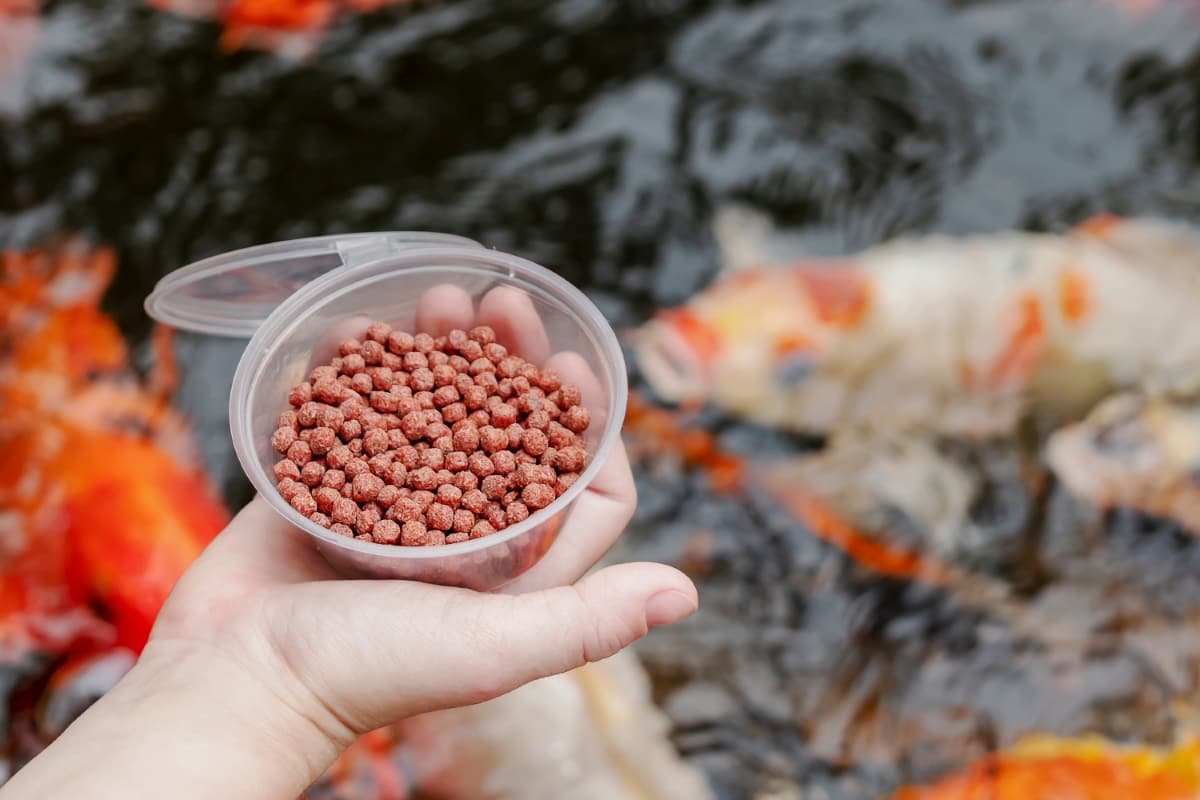Understanding the intricacies of fish feeding is essential for the health and growth of various freshwater fish species. Each species has unique dietary requirements, making it vital to tailor their feed accordingly. The types of fish feed play a crucial role, encompassing a range of fish feed ingredients to meet their nutritional needs.

Fish compatibility charts are useful tools in identifying which species can coexist harmoniously, ensuring a stress-free environment conducive to healthy feeding habits. Fish feeding calculation is an important aspect, requiring attention to the fish’s age, size, weight, and specific dietary needs. Natural fish feed is often preferred for its nutritional benefits and closer resemblance to a fish’s diet in the wild.
Fish Feed Chart
Nutritional Requirements of Fresh-Water Fish
Freshwater fish have diverse nutritional requirements based on their species. Various factors, including metabolic rate, activity level, water temperature, and reproductive status influence these requirements. The primary components of fish feed include proteins, fats, carbohydrates, vitamins, and minerals.
Proteins are crucial for growth and repair, while fats provide energy. Carbohydrates, though less important, serve as an additional energy source. Vitamins and minerals are essential for physiological functions and maintaining health. Balancing these nutrients is key to promoting optimal growth and health in freshwater fish.
Tilapia Fish
Tilapia, a popular freshwater species, thrives on a diet rich in proteins and moderate in fats. They require frequent feeding, typically 2-3 times a day, with the amount depending on their size and age. Young tilapia should be fed smaller, more frequent meals, focusing on high-protein feeds to support their rapid growth. As they mature, the protein content can be reduced, and the feeding frequency decreases. Adult tilapia generally require about 2-3% of their body weight in feed daily.
Catfish
Catfish are bottom dwellers with a preference for high-protein and high-fat diets. They are typically fed once or twice a day, and the feeding amount should be around 3-4% of their body weight. Catfish feed should include a variety of ingredients to meet their nutritional needs, including animal proteins and plant-based nutrients. Juvenile catfish require more frequent feedings with higher protein content to support their growth, whereas adults can be fed less frequently with a more varied diet. Proper feeding ensures healthy growth and helps in maintaining the desired size and weight of the catfish.
Trout Fish
Trout fish are carnivorous and require a diet high in protein, usually from animal sources. They should be fed 1-2 times daily, with the feed amounting to 1-2% of their body weight, depending on their age and size. Young trout need frequent feedings of high-protein feed to support their rapid growth, while adult trout can be fed less often with a more varied diet. The feed should be well-balanced, incorporating all essential nutrients to maintain their health and ensure optimal growth.
In case you missed it: Fish Farming Project Report: Production Economics, Cost, and Profit Analysis

Carp Fish
Carp are omnivorous and have a diverse diet. They should be fed 1-2 times per day, with feed amounting to about 3-5% of their body weight, depending on age and size. Young carp require frequent feeding with a higher proportion of proteins, while adults can be fed less frequently with a more varied diet. Carp feed should include both animal and plant-based ingredients to ensure a balanced intake of nutrients, aiding in their growth and overall health.
Salmon Fish
Salmon, a highly sought-after fish, requires a diet rich in proteins and fats. They are typically fed 1-2 times daily, with the feeding amount being about 1-2% of their body weight. Young salmon need a protein-rich diet for optimal growth, whereas adults require a well-rounded diet with diverse nutrients. Ensuring the feed is rich in essential fatty acids is important for the health and growth of salmon.
Perch Fish
Perch fish prefer a diet that includes both animal and plant-based components. They should be fed 1-2 times a day, with the amount of feed being around 2-3% of their body weight. Juvenile perch require high-protein feed for growth, while adults can have a more diverse diet. It is crucial to offer a well-rounded diet that fulfills their nutritional requirements to support their health and development effectively.
Pike Fish
Pike fish are predatory and require a diet high in protein, mainly from animal sources. They should be fed once daily, with the feed amounting to about 2-3% of their body weight. Young pike needs a diet rich in protein for their growth, while adults can be fed a more varied diet. It is imperative to guarantee that the feed is properly balanced to meet their nutritional requirements, as this is vital for their well-being and development.
Bass Fish
Bass fish are carnivorous and prefer a diet high in animal proteins. They should be fed once or twice a day, with the feed amount being about 2-3% of their body weight. Juvenile bass require high-protein feed for growth, while adults can have a more varied diet. The feed should be balanced and tailored to meet their specific nutritional requirements for healthy growth.
Catla Fish
Catla fish, predominantly found in South Asia, thrive on a varied diet. They should be fed 2-3 times a day, with the feed amounting to about 3-4% of their body weight. The diet of young catla should be rich in protein to support growth, while adults can have a more varied diet. Ensuring the feed includes a balance of animal and plant-based nutrients is essential for their overall health and growth.
In case you missed it: Fish Farming Regulations and Permits: Every First-Time Fish Farmer Should Know These

Crappie Fish
Crappie fish, known for their diverse diet, require balanced nutrition for optimal growth. They typically feed on small fish and insects, making a diet rich in protein essential. Feeding should occur 1-2 times daily, with the amount of feed being about 2-3% of their body weight. Young crappie fish require more frequent feeding with a higher protein content to facilitate their rapid growth. As they mature, the feeding frequency can be reduced, with a shift towards a more varied diet that includes both animal and plant-based nutrients. This balanced approach helps maintain their health and supports steady growth.
Murrel/Snakehead Fish
Murrel, also recognized as the Snakehead fish, are carnivorous and need a protein-rich diet from animal origins. They should be fed once or twice a day, with the feed amounting to approximately 3-4% of their body weight, depending on age and size. Juvenile murrels need frequent, protein-rich feedings to support their growth, while adults can be fed less often with a more diverse diet. The diet should consist of a combination of fish, insects, and small aquatic creatures to support healthy growth and development through a nutrient-rich intake.
Rohu Fish
Rohu fish, a common species in South Asia, prefer a diet that includes both plant and animal matter. They should be fed 2-3 times per day, with the feeding amount being about 3-4% of their body weight. Young rohu fish require frequent feeding with a higher proportion of proteins to support their growth, while adults can be fed less frequently with a more diverse diet. It’s important to provide a balanced diet that includes a variety of nutrients to ensure their overall health and optimal growth.
Eel Fish Fish
Eel fish have a unique diet, primarily feeding on worms, small fish, and crustaceans. They require feeding once or twice a day, with the feed amount being about 2-3% of their body weight, depending on their size and age. Young eels need more frequent feeding with high protein content, while adult eels can be fed less often with a more varied diet. A balanced diet, rich in animal proteins and essential nutrients, is crucial for their health and growth, ensuring they reach their full potential in size and weight.
Fish Feed Chart for Different Fresh-Water Fish Species
| Fish Species | Feeding Frequency | Amount of Feed |
| Tilapia | 2-3 times/day | 2-3% of body weight |
| Catfish | 1-2 times/day | 3-4% of body weight |
| Trout | 1-2 times/day | 1-2% of body weight |
| Carp | 1-2 times/day | 3-5% of body weight |
| Salmon | 1-2 times/day | 1-2% of body weight |
| Perch | 1-2 times/day | 2-3% of body weight |
| Pike | Once a day | 2-3% of body weight |
| Bass | 1-2 times/day | 2-3% of body weight |
| Catla | 2-3 times/day | 3-4% of body weight |
| Crappie | 1-2 times/day | 2-3% of body weight |
| Murrel/Snakehead | 1-2 times/day | 3-4% of body weight |
| Rohu | 2-3 times/day | 3-4% of body weight |
| Eel | 1-2 times/day | 2-3% of body weight |
In case you missed it: Top 10 Common Mistakes to Avoid in Fish Farming

Conclusion
The dietary needs of different freshwater fish species are as diverse as the species themselves. From Tilapia to Eel, each fish requires a specific diet tailored to its unique nutritional needs, which vary with age, size, and weight.
- Feed Your Flock for Less: Top 10 Tips to Save on Chicken Feed
- Ultimate Guide to Ossabaw Island Hog: Breeding, Raising, Diet, and Care
- Hatching Answers: The Top 10 Reasons Your Chickens Aren’t Laying Eggs
- Eggs and Economics: Breaking Down the Cost of Raising Backyard Chickens
- Defend Your Greens: Proven Methods to Keep Iguanas Out of Your Garden
- Ultimate Guide to Cinnamon Queen Chicken: A Comprehensive Guide for Beginners
- Ultimate Guide to California Tan Chicken: Breeding, Raising, Diet, Egg-Production and Care
- Ultimate Guide to Marsh Daisy Chicken: Breeding, Raising, Diet, and Care
- 10 Types of Chicken Farming Businesses You Can Start for Profits